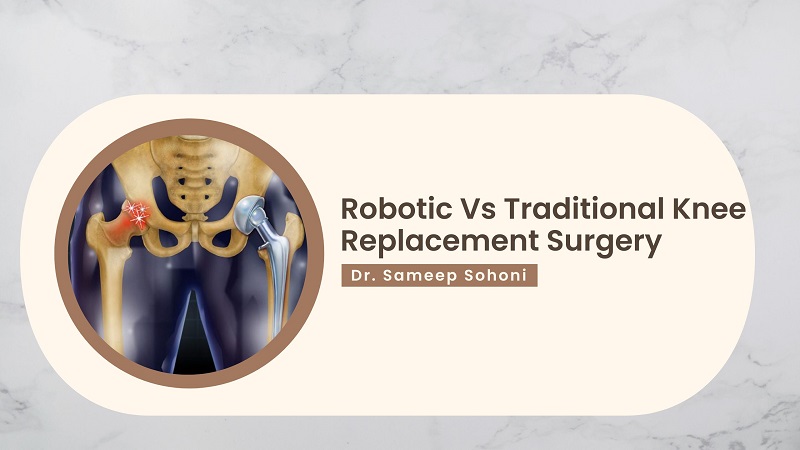Robotic vs Traditional Knee Replacement Surgery: Learn From An Acclaimed Orthopedic Doctor in Thane

Knee replacement surgery is generally done to relieve pain caused by arthritis. People who need knee replacement surgery habitually have problems in walking, climbing stairs and getting up out of chairs. If you are in need of knee replacement surgery; you may choose to go either for robotic or traditional process. Confused with robotic vs traditional knee replacement surgery? Read on.
In this write-up, Dr. Sameep Sohoni, the best robotic knee replacement doctor in Thane explains robotic vs traditional knee replacement surgery.
Robotic vs Traditional Knee Replacement Surgery
Traditional and robotic knee replacement are both surgical methods that substitute injured tissue in the knee with an artificial joint. The core difference is that in traditional knee replacement, the entire procedure is performed manually by the surgeon while robotic knee replacement is a computer-assisted technology to support the surgeon. Robotic knee replacement surgery to put it in simple words, offers greater accuracy, fewer hitches, lower risk of infection, and faster recovery than traditional knee replacement.
Let’s compare the key aspects of the procedures:
Surgical Technique
In a traditional knee replacement, knee replacement surgeons use X-ray imaging for visual assessment and manual practices to take away the damaged portion of the bone and cartilage.
The robotic knee replacement surgery involves innovative technology to support the surgeon. 3D imaging and real-time adjustments allow accurate implant placement. A robotic knee replacement doctor in Mumbai uses robotic support to prepare the bone surface and place the artificial joint components.
Incision
The traditional knee replacement process includes making a long incision of about 10-12 inches long using orthodox surgical tools, leading to more tissue interruption and longer recovery.
Robotic surgery habitually uses smaller incisions, causing lesser tissue disturbance, reduced scarring, and faster healing.
Precision
The precision of traditional knee surgery mostly depends on the surgeon’s expertise and experience.
The robotic knee replacement surgery however, gives a higher level of accuracy. This is because of its ability to follow pre-programmed plans and make real-time adjustments.
Recovery Time
Patients take longer recovery time after traditional knee replacement surgery because of larger incisions and greater tissue trauma during the procedure.
Patients habitually experience less pain, reduced swelling, and quicker reintegration. Robotic surgery needs smaller incisions and hence there is minimised tissue trauma.
Personalization
Though effective, traditional surgery follows a standardized approach that might not account for modifications as per individual’s needs.
Robotic surgery’s 3D imaging permits precise customization of the surgical strategy to match the patient’s unique joint structure.
Patient Result
Traditional knee surgery can give positive results, relieving discomfort and improving joint function. Results may differ based on the surgeon’s skill and unique patient condition.
Robotic-assisted assures enhanced accuracy to improve joint function, lessen pain, and potentially improve enduring consequences.
Now that you know that Robot-assisted knee replacement surgery offers several advantages over the traditional approach, you must be looking to learn the disadvantages too (if any) Let’s explain.
Advantages and Disadvantages of Robotic Knee Replacement
Listing a few advantages of robotic knee replacement surgery
- Improved accuracy
- Minimal invasion
- Personalized implant placement
- Reduced damage to surrounding tissues
- Potential for quicker recovery
Disadvantages of Robotic Knee Replacement:
- Patient Restrictions
- Limited Availability
- Longer Surgery Tim
- Dependency on Technology
- Higher Cost
Who is a Good Candidate for Robotic Knee Replacement?
According to Dr. Sameep Sohoni the most acclaimed Orthopedic doctor in Thane, a good candidate for robotic knee replacement is one who:
- Have osteoarthritis that has caused moderate to excessive pain
- A patient who isn’t responding to conservative treatments
- Have joint impairment visible on x-rays
- Patient with damage to the femur due to an injury
- Candidate with advanced osteoarthritis because of normal age-related changes like thinning cartilage
- Have injury on or surrounding the knee
- Have previous surgeries and hardware in the femur or tibia near the knee
- Are under the age of 65 years old with good health
Types of Robotic Knee Replacement
- Partial Robotic Knee Replacement …
- Total Robotic Knee Replacement Comprehensive Joint Restoration
- Customized Implants
- Minimally Invasive Robotic Surgery
What is the Success Rate of Robotic Knee Replacement?
The accomplishment rate of robotic knee replacement surgery is usually high, with lower complication rates in the initial three months post-surgery: 1.5% versus 2.6% in traditional knee replacement surgeries.
Conclusion
Now you have a detailed knowledge of robotic vs traditional knee replacement surgery. Discuss with Dr. Sameep Sohoni the best robotic knee replacement doctor in Thane and enjoy a pain-free life.
FAQs
Problems with Robotic Knee Surgery
- Pin-hole fractures
- Pin-related infections
- Soft tissue and bony injuries
Excessive bleeding
- Nerve damage
- Blood clots
- Infection
- Allergic reaction
- Implant wear and loosening
- Pulmonary embolism
- Expensive
- Longer operation duration
Is Robotic Knee Replacement Covered by Insurance?
Robotic knee replacement is normally covered by most insurance plans.
If you found the post helpful, please don’t keep it to yourself. Pass it on to help others too. Like and Share.

 Previous Post
Previous Post Next Post
Next Post
